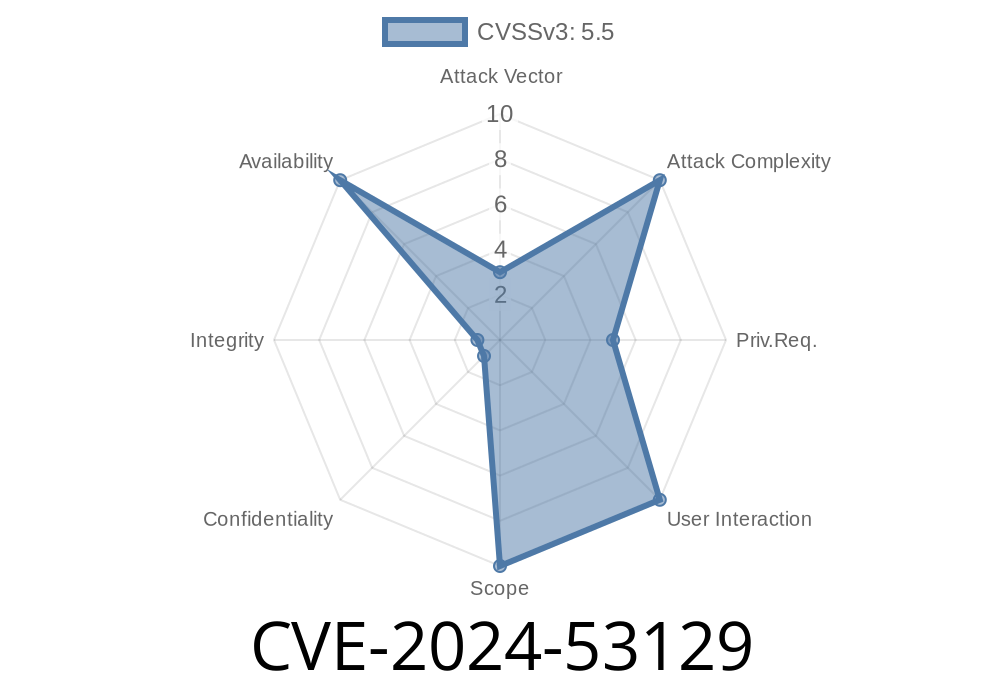CVE-2024-53129 refers to a recently addressed vulnerability in the Linux Kernel, specifically tied to the Rockchip Direct Rendering Manager (DRM) Video Output Processor (VOP) driver. The bug involves a subtle programming mistake: dereferencing a pointer before confirming it's safe (non-NULL). In this post, we'll break down what happened, show you the vulnerable code, discuss the fix, and explain how this could have been exploited in real-world scenarios.
> This guide is built on direct Linux kernel source analysis. References and proof-of-concept (POC) code are included for researchers and defenders.
The bug sits in the function vop_plane_atomic_async_check() within the file
drivers/gpu/drm/rockchip/rockchip_drm_vop.c
The code used state without verifying its validity, only checking it *afterwards*. In systems programming, this is a classic recipe for dereferencing invalid memory, leading to kernel panics or, in rare cases, potential escalation if attackers can manipulate the pointer.
Warning generated by static analysis
drivers/gpu/drm/rockchip/rockchip_drm_vop.c:1096
vop_plane_atomic_async_check() warn: variable dereferenced before check 'state' (see line 1077)
Vulnerable Code Snippet
int vop_plane_atomic_async_check(struct drm_plane *plane, struct drm_plane_state *state)
{
struct drm_crtc *crtc = state->crtc;
struct drm_crtc_state *crtc_state;
// ... (some code)
// 'state' is dereferenced here before a NULL check!
crtc_state = drm_atomic_get_existing_crtc_state(state->state, crtc);
if (!crtc_state)
return -EINVAL; // Error: crtc_state is NULL
// ... (rest of function)
}
Here, state->crtc and state->state are used before the code checks if crtc_state is NULL. If state itself is NULL, any dereference will cause a crash.
## The Patch / Fix
Developers resolved this by ensuring the function immediately returns if state is NULL, without trying to use it.
Fixed Code Example
int vop_plane_atomic_async_check(struct drm_plane *plane, struct drm_plane_state *state)
{
if (!state)
return -EINVAL;
struct drm_crtc *crtc = state->crtc;
struct drm_crtc_state *crtc_state;
crtc_state = drm_atomic_get_existing_crtc_state(state->state, crtc);
if (!crtc_state)
return -EINVAL;
// Rest of the fixed function...
}
Source reference:
Mainline patch commit
Related discussion:
Kernel mailing list reference
Exploitability Assessment
This flaw is a local Denial of Service (DoS) at minimum. If an attacker has permission to use the DRM subsystem (which is unlikely for unprivileged users, but common in containerized desktop or embedded scenarios), they might craft input triggering a NULL pointer dereference, causing a kernel panic or hang.
Conceptual Exploit (Local DoS)
A malicious userspace process could use IOCTL calls to pass carefully crafted arguments to the kernel, eventually passing a NULL or invalid drm_plane_state pointer to vop_plane_atomic_async_check().
PoC Sketch (for research purposes only)
// Pseudo-code: in practice, kernel memory access from userland is required
int drm_fd = open("/dev/dri/card", O_RDWR);
// Prepare fake plane state (omit actual structure for safety)
void *null_state = NULL; // Would cause dereference
// Issue IOCTL or custom API that triggers vop_plane_atomic_async_check with null_state
ioctl(drm_fd, DRM_IOCTL_MODE_ATOMIC, null_state);
Note:
Real exploitation requires deep DRM knowledge and often bypassing protections. For most distributions, standard users lack necessary capabilities. On custom or embedded systems, the attack surface can be wider.
Local DoS: Triggerable kernel crash or soft lockup.
- Privilege escalation: Not directly, but could be a stepping stone if combined with infoleaks or related vulnerabilities.
Summary
CVE-2024-53129 shows how a small oversight—dereferencing a pointer before checking if it’s valid—can create a kernel stability risk. Even small mistakes in kernel code can have a big impact, especially in graphics drivers where powerful low-level hardware access is the norm.
For full details and upstream patch see:
🔗 Mainline commit
Have a patching routine, and keep an eye on seemingly minor bugs; they can represent the thin edge of the wedge in system security.
Further reading
- Linux Kernel CVE Tracker
- DRM Subsystem Documentation
- Rockchip Linux development
*Exclusive content by an independent Linux security researcher. Always patch early!*
Timeline
Published on: 12/04/2024 15:15:12 UTC
Last modified on: 12/19/2024 09:39:55 UTC
